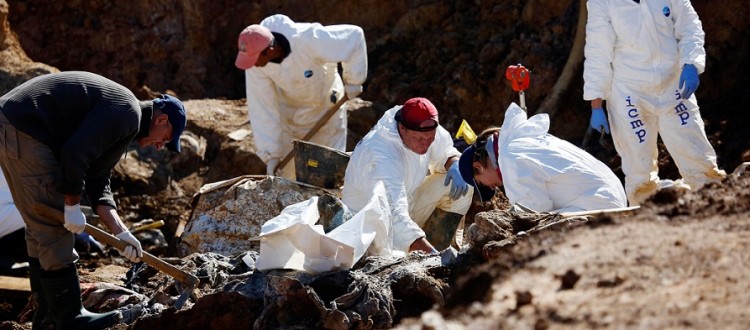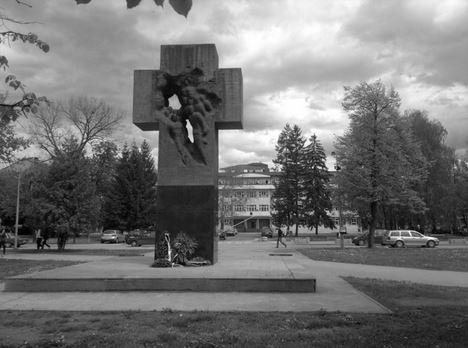The banality of evil in Republika Srpska – a victim’s perspective
Almost twenty years after the Srebrenica genocide and ethnic cleansing in Prijedor, the Republika Srpska government still broadly denies these traumatic experiences of Bosniaks and Croats through various forms of structural discriminatory policies. These exclusivist discriminatory politics are based on lingering Serbian nationalism that originated in the eighties.
| Suggested Reading | Collaborative Conflict Transformation | GCCT |
By Haris Subašić
On 6th November 2013, the mayor of Prijedor, Marko Pavić, visited Tomasica, the biggest mass grave discovered in Prijedor, which concealed approximately 435 of the 1,200 still missing non-Serb victims. Pavić went there to express his deepest remorse to the survivors’ families. However, local non-Serb survivors recall Pavić’s role in 1992 as complicity with evil. Pavić was the director of the main post office in Prijedor. During the war, telecommunications would be regularly turned-off when crimes against non-Serbs were being committed, according to Muharem Murselemović. Milka Šarić’s life story about the death of her husband, Silvije Šarić, secretary of the post office and Pavić’s former colleague, in Omarska camp testifies to Pavic’s ignorance of Milka’s desperate appeals to help her to save her husband.
According to evidence from ‘Izvor’, the non-Serb victim association, approximately 58 mass graves have been discovered in Bosanska Krajina, among which the largest and most well known are: Tomasica, Stari Kevljani, Jakarina Kosa, Redak (Prijedor), Hrastova Glavica (Sanski Most) and Jama Lisac (Bosanska Krupa). Furthermore, over 100 individual graves have been found, among which the “identified victims were mainly from the Prijedor concentration camps”. Hata Tatarević’s case, a Bosniak who lost six sons and a husband, whose only crime was belonging to a different ethnic group, is a well-known example of the refusal of the local government and Serb citizens in Prijedor to provide full support to the ongoing search for missing non-Serbs.
At the entity level, Republika Srpska’s Zakon o Zastiti Civilnih Zrtava Rata is an inadequate and discriminatory law, created for the so-called “civil victims of war” in order to ensure reparations. However, it does not include restitution or satisfaction as a moral and symbolic type of reparation for non-Serbs. An individual right to compensation provides insufficient material compensation and an unreasonable time period for non-Serbs to apply for this right, according to the testimony of victims. Rehabilitation is very poorly=funded, as it is explicitly related to the disability insurance fund, and not specifically in any way addressed to the real needs of non-Serb victims. Article 4 differentiates enemies among victims as “persons who were members of enemy formations, that is, their aides“ have no right to reparations. It means that those who were unlawfully detained and tortured in Prijedor camps, who afterwards joined the Army of B-H, are not able to enjoy the right to reparation.
After the Second World War, many genocide scholars who conducted research on Nazi perpetrators’ denial of war crimes found that they usually develop a “paradoxical morality”; they would feel guilt and shame when recalling a vivid memory of a single act they had committed, which by the time helps them to forge a sense of their own humanity and a repression of all the other atrocities they committed. In this way they have a “conscience at rest”, while victims usually feel traumatized for one succeeding generation, especially if the society in which they live encourages “escape routines” of perpetrators, as is the case with the denial of victims’ rights for justice and truth in Republika Srpska. Consequently, justice and victims’ dignity will not be restored, moral codes as well as respect for law and government will decrease, and as many transitional justice experts assert, lasting reconciliation will not be possible if an accurate historical record is not secured.
Today the prevailing attitude in Republika Srpska is a culture of denial about mass crimes against non-Serbs, which is mostly visible through the memorial culture of the so-called “Serbian defensive-liberation war”, legal and political manipulations by local and entity government officials, and political support of this discriminatory discourse by ordinary citizens. “For the Honorable Cross” represents the biggest Serbian monument of a new political and cultural reality created for non-Serb survivors in Prijedor that was erected in 1999 with the aim of intimidation of Bosniak and Croat returnees, according to victims’ testimonies.
The monument ‘For the Honorable Cross’ erected in the park in front of Prijedor town hall. Photo by Saša Savić.
Nowadays, the President of Republika Srpska, Milorad Dodik, states that “the Srebrenica genocide did not happen”, despite verdicts asserted by international courts, namely the ICTY and the ICJ.
Some scholars claim that there would be no mass crimes against non-Serbs if there was no “explicit national ideology“ of an utopian homogeneous Great Serbia, envisioned by the “architect of genocide“ and academic, Dobrica Ćosić, and a “talented planner“ and politician, Slobodan Milosevic. They invoked the “supposedly glorious history of Serbs and their tragic present“ of economic upheaval and political dislocation, of which other inferior groups such as Muslims, Croats, and Westerners were guilty. Through a system that spread false information, they gradually and transnationally provided an alternative social and moral network of a Great Serbia, instead of “Brotherhood and Unity”, enabling many ordinary Serbs to turn from good neighbours and friends to people who committed genocide against non-Serbs in Bosnia-Herzegovian. Some were “desk murders“ (i.e. professors, doctors, politicians etc.), or “shooters“, (i.e. police or military officials). On 20th June 1992, Dusko Tadic killed his best friend Emir Karabasic in Omarska camp. Later on, Milosevic was placed on trial for genocide by the ICTY.
The ICTY affirmed that ethnic cleansing against non-Serb civilians ocured in Prijedor, led by local Bosnian Serb political, police and other forces with the aim to create a pure Serb state. Further, the Bosnian Serb forces executed 7,000 to 8,000 Bosnian Muslim prisoners from Srebrenica in July 1995 during the Srebrenica genocide.
Today, the government of Republika Srpska and local politicians are carrying out structural discriminatory policies, aimed at survivors based on their ethnic origins, by providing no adequate satisfaction, justice, accurate public records, and a legally-regulated prohibition of the denial of mass crimes against non-Serbs. The victims feel threatened in a sense of “defensiveness and grievance”.
Haris Subašić is currently a PhD student in Human Rights at Hacettepe Üniversitesi (Turkey). Haris previously worked as a research assistant at King’s College London on a project entitled, “Pictures of Peace and Justice Documentation, Evidence and Impact of Visual Material in International War Crimes Prosecution”.





















RT @TransConflict: The banality of evil in Republika #Srpska – a victim’s perspective: Almost twenty – #Bosnia – http://t.co/rGBEaIZunS
#TransConflict The banality of evil in Republika Srpska – a victim’s perspective: Almost twenty years after th… http://t.co/n6EPZMBjt6
RT @TransConflict: The banality of evil in Republika #Srpska – a victim’s perspective: Almost twenty – #Bosnia – http://t.co/rGBEaIZunS
‘The banality of evil in Republika #Srpska – a victim’s perspective’ by @HSXSPAAA – #Bosnia-#Herzegovina – http://t.co/zc7F57lR0U
RT @TransConflict: ‘The banality of evil in Republika #Srpska – a victim’s perspective’ by @HSXSPAAA – #Bosnia-#Herzegovina – http://t.co/z…
RT @TransConflict: ‘The banality of evil in Republika #Srpska – a victim’s perspective’ by @HSXSPAAA – #Bosnia-#Herzegovina – http://t.co/z…
RT @TransConflict: The banality of evil in Republika #Srpska – a victim’s perspective: Almost twenty – #Bosnia – http://t.co/rGBEaIZunS
RT @TransConflict: The banality of evil in Republika #Srpska – a victim’s perspective: Almost twenty – #Bosnia – http://t.co/rGBEaIZunS
The banality of evil in Republika #Srpska – a victim’s perspective – #Bosnia-#Herzegovina – http://t.co/0YhZ1SyeJi
RT @TransConflict: The banality of evil in Republika #Srpska – a victim’s perspective: Almost twenty – #Bosnia – http://t.co/rGBEaIZunS
RT @TransConflict: The banality of evil in Republika #Srpska – a victim’s perspective: Almost twenty – #Bosnia – http://t.co/rGBEaIZunS
RT @TransConflict: The banality of evil in Republika #Srpska – a victim’s perspective: Almost twenty – #Bosnia – http://t.co/rGBEaIZunS
The banality of evil in Republika Srpska – a victim’s perspective – TransConflict – http://t.co/xAHFpLIcSM
RT @kennethandresen: The banality of evil in Republika Srpska – a victim’s perspective – TransConflict – http://t.co/xAHFpLIcSM
Republika Srpska culture of denial & struggle of victims #Bosnia #transitionaljustice #Prijedor http://t.co/UWPjdPhxuC via @TransConflict
RT @kabitha1430: Republika Srpska culture of denial & struggle of victims #Bosnia #transitionaljustice #Prijedor http://t.co/UWPjdPhxuC vi…
A good read… http://t.co/kmvLSSx20T
The banality of evil in Republika #Srpska – a victim’s perspective #Bosnia #Genocide cc @AngryBosnianFan http://t.co/QuwT6RId4A
RT @MirzaHota: The banality of evil in Republika #Srpska – a victim’s perspective #Bosnia #Genocide cc @AngryBosnianFan http://t.co/QuwT6R…
Today the prevailing attitude in Republika Srpska is a culture of denial about mass crimes against non-Serbs,… http://t.co/zrmlXyk6iX
RT @TransConflict: The banality of evil in Republika #Srpska – a victim’s perspective – #Bosnia-#Herzegovina – http://t.co/0YhZ1SyeJi
RT @MirzaHota: The banality of evil in Republika #Srpska – a victim’s perspective #Bosnia #Genocide cc @AngryBosnianFan http://t.co/QuwT6R…
“The Banality of Evil in Republika Srpska” http://t.co/80Xr0l2lgl
“The banality of evil in Republika Srpska – a victim’s perspective” http://t.co/MfFfSuCeHp
RT @HSXSPAAA: “The banality of evil in Republika Srpska – a victim’s perspective” http://t.co/MfFfSuCeHp
RT @HSXSPAAA: “The banality of evil in Republika Srpska – a victim’s perspective” http://t.co/MfFfSuCeHp
The banality of evil in Republika Srpska – a victim’s perspective – TransConflict http://t.co/0cun2HEZx9
The banality of evil in #Bosnia’s Republika #Srpska http://t.co/YmeW7Lgzh4 #warcrimes #genocide #Prijedor #Srebrenica via @TransConflict
RT @NedadMemic: The banality of evil in #Bosnia’s Republika #Srpska http://t.co/YmeW7Lgzh4 #warcrimes #genocide #Prijedor #Srebrenica via @…
A culture of denial #RepublikaSrpska #BIH http://t.co/itaeTDxPcY
RT @NedadMemic: The banality of evil in #Bosnia’s Republika #Srpska http://t.co/YmeW7Lgzh4 #warcrimes #genocide #Prijedor #Srebrenica via @…
Pingback : Top 15 articles of 2015 - TransConflict